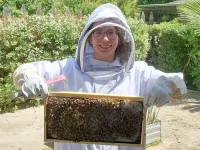(Press-News.org) A new analysis from University of Toronto Engineering researchers leverages machine learning to help answer a thorny question: where should new protected bike lanes be placed to provide maximum benefit?
“Right now, some people have really good access to protected biking infrastructure: they can bike to work, to the grocery store or to entertainment venues,” says Madeleine Bonsma-Fisher, a postdoctoral fellow in the Department of Civil & Mineral Engineering and lead author of a new paper published in the Journal of Transport Geography.
“More lanes could increase the number of destinations they can reach, and previous work shows that will increase the number of cycle trips taken.
“However, many people have little or no access to protected cycling infrastructure at all, limiting their ability to get around. This raises a question: is it better to maximize the number of connected destinations and potential trips overall, or is it more important to focus on maximizing the number of people who can benefit from access to the network?”
Bonsma-Fisher and her team — including her co-supervisors, Professors Shoshanna Saxe and Timothy Chan, and PhD student Bo Lin — use machine learning and optimization to help inform such decisions. It’s a challenge that required new computational approaches.
“This kind of optimization problem is what’s called an NP-hard problem, which means that the computing power needed to solve it scales very quickly along with the size of the network,” says Saxe.
“If you used a traditional optimization algorithm on a city the size of Toronto, everything would just crash. But PhD student Bo Lin invented a really cool machine learning model that can consider millions of combinations of over 1,000 different infrastructure projects to test what are the most impactful places to build new cycling infrastructure.”
Using Toronto as a stand-in for any large, automobile-oriented North American city, the team generated maps of future bike lane networks along major streets, optimized according to two broad types of strategies.
The first, which they called the utilitarian approach, focused on maximizing the number of trips that could be taken using only routes with protected bike lanes in under 30 minutes — without regard for who those trips were taken by.
The second, which they termed equity-based, aimed to maximize the number of people who had at least some connection to the network.
“If you optimize for equity, you get a map that is more spread out and less concentrated in the downtown areas,” says Bonsma-Fisher.
“You do get more parts of the city that have a minimum of accessibility by bike, but you also get a somewhat smaller overall gain in average accessibility.”
“There is a trade-off there,” says Saxe.
“This trade-off is temporary, assuming we will eventually have a full cycling network across the city, but it is meaningful for how we do things in the meantime and could last a long time given ongoing challenges to building cycling infrastructure.”
Another key finding was that there are some routes that appeared to be essential no matter what strategy was pursued.
“For example, the bike lanes along Bloor West show up in all of the scenarios,” says Saxe.
“Those bike lanes benefit even people who don’t live near them and are a critical trunk to maximizing both the equity and utility of the bike network. Their impact is so consistent across models that it challenges the idea that bike lanes are a local issue, affecting only the people close by. Optimized infrastructure repeatedly turns out in our model to serve neighbourhoods quite a distance away.
The team is already sharing their data with Toronto’s city planners to help inform ongoing decisions about infrastructure investments. Going forward, the team hopes to apply their analysis to other cities as well.
“No matter what your local issues, or what choices you end up making, it’s really important to have a clear understanding of what goals you are aiming for and check if you are meeting them,” says Bonsma-Fisher.
“This kind of analysis can provide an evidence-based, data-driven approach to answering these tough questions.”
END
Machine learning analysis sheds light on who benefits from protected bike lanes
University of Toronto Engineering analysis optimizes the placement of cycling infrastructure in Toronto according to different strategies — and finds a trade-off between equity and efficiency
2024-10-15
ELSE PRESS RELEASES FROM THIS DATE:
New research reveals how large-scale adoption of electric vehicles can improve air quality and human health
2024-10-15
A new study from the University of Toronto's Department of Civil & Mineral Engineering suggests that large-scale adoption of electric vehicles (EVs) could lead to significant population-level health benefits.
The research team used computer simulations to show that aggressive electrification of the U.S. vehicle fleet, coupled with an ambitious rollout of renewable electricity generation, could result in health benefits worth between US$84 billion and 188 billion by 2050.
Even scenarios with less aggressive grid decarbonization mostly predicted health benefits running into the tens of billions of dollars.
“When ...
Florida Inventors Hall of Fame invites nominations for 2025 inductees
2024-10-15
TAMPA, Fla. (Oct. 15, 2024) -- The Florida Inventors Hall of Fame is inviting nominations for the 2025 class of inductees. This award recognizes distinguished inventors with a connection to Florida, whose achievements have advanced quality of life for the state and the nation.
“Inductees to the Florida Inventors Hall of Fame represent some of our nation’s greatest inventors from across academia, industry and government,” said Paul Sanberg, chair of the Florida Inventors Hall of Fame Advisory Board and president of the National Academy of Inventors. “Their achievements underscore the critical role that innovation plays in driving ...
Election officials can boost voter trust in delayed results with early communication
2024-10-15
In recent U.S. elections, results often took days to finalize, fueling voter distrust in the electoral process and ballot outcomes. Now, research from the Yankelovich Center for Social Science Research at UC San Diego shows that a simple, proactive message from election officials – ahead of Election Night – can effectively reduce this distrust.
The study, published in PNAS Nexus, reveals that when voters are informed in advance that counting ballots accurately takes time and there are security measures in place, their trust in the process remains steady, even when results are delayed.
“Election officials ...
Rice-led research will leverage responsible AI to enhance coastal communities’ severe storm response
2024-10-15
HOUSTON – (Oct. 15, 2024) – An interdisciplinary team of Rice University engineers and collaborators led by Jamie Padgett has won $1.5 million from the National Science Foundation (NSF) to improve the safety and resiliency of coastal communities facing compounded risk from hazardous weather events.
Padgett, together with Ben Hu and Avantika Gori at Rice, David Retchless at Texas A&M University at Galveston and community partners, will leverage responsible artificial intelligence (AI), hazard and resilience models ...
Honey bees in demand: New contract strategies to support pollination services
2024-10-15
URBANA, Ill. — As the world’s native bee populations are declining, crop production requiring pollinators increasingly relies on commercial pollination services. In the U.S., the beekeeping industry is in great demand, and truckloads of bee colonies travel the country to accommodate crop growers. A new study from the University of Illinois Urbana-Champaign looks at pollination contracts between beekeepers and California almond growers, exploring clauses that could make the agreements more appealing for both parties.
“There's about 1.3 million acres of almond trees ...
New climate change health research center under development at the University of Cincinnati
2024-10-15
Climate change presents far-reaching implications for the planet’s weather, sea levels, animals and food supply. Now experts are addressing climate change’s adverse effects on human health.
“We need to try to reduce risks for people, especially vulnerable populations,” said Ardythe Morrow, PhD, MSc, professor and director of the Epidemiology division of the Department of Environmental and Public Health Sciences at the University of Cincinnati College of Medicine.
To that end, the National Institute of Environmental Health Sciences of the National Institutes of Health has awarded a three-year, $4 million ...
Educational psychologists can play a part in fighting TikTok mental health and neurodiversity misinformation
2024-10-15
Educational psychologists could help to fight mental health and neurodiversity misinformation on TikTok as more young people self-diagnose based on poor quality content on the platform, a new study says.
Growing numbers of young people may be labelling themselves as being neurodivergent or having mental health conditions after engaging with information online, some of which may be inaccurate.
Educational psychologists and their professional bodies could engage with TikTok by creating accessible evidence-based content about neurodiversity and mental health on the platform.
Their assessments could also ...
Winners announced in $300,000 pediatric medical device competition focused on pediatric cardiology
2024-10-15
WASHINGTON (Oct. 15, 2024)—Six medical technology innovators focused on pediatric cardiology were selected to receive grants of $50,000 each in the “Make Your Medical Device Pitch for Kids!TM” competition in Toronto. The funds will help awardees bring their devices to the market and improve care for children with heart conditions.
The awardees, selected from a highly competitive field of ten finalists, are:
Bloom Standard, Minneapolis—Autonomous, hands-free ultrasound
Compremium AG, Bern, Switzerland—Noninvasive central venous pressure estimation for pediatric patients
Massachusetts ...
New app performs real-time, full-body motion capture with a smartphone
2024-10-15
Northwestern University engineers have developed a new system for full-body motion capture — and it doesn’t require specialized rooms, expensive equipment, bulky cameras or an array of sensors.
Instead, it requires a simple mobile device.
Called MobilePoser, the new system leverages sensors already embedded within consumer mobile devices, including smartphones, smart watches and wireless earbuds. Using a combination of sensor data, machine learning and physics, MobilePoser accurately ...
Immune signatures may predict adverse events from immunotherapy
2024-10-15
Distinct immune “signatures” in patients who develop adverse events while taking immunotherapy for cancer may help oncologists identify patients at risk and treat them early to prevent serious side effects, suggests a study by researchers from the Johns Hopkins Kimmel Cancer Center and its Bloomberg~Kimmel Institute for Cancer Immunotherapy.
The study, published Oct. 15 in the Journal of Clinical Investigation, is the largest to date to look at immune signatures in patients with a range of cancers. It included a diverse sample of 111 patients treated with immune checkpoint inhibitors ...
LAST 30 PRESS RELEASES:
Numbers in our sights affect how we perceive space
SIMJ announces global collaborative book project in commemoration of its 75th anniversary
Air pollution exposure and birth weight
Obstructive sleep apnea risk and mental health conditions among older adults
How talking slows eye movements behind the wheel
The Ceramic Society of Japan’s Oxoate Ceramics Research Association launches new international book project
Heart-brain connection: international study reveals the role of the vagus nerve in keeping the heart young
Researchers identify Rb1 as a predictive biomarker for a new therapeutic strategy in some breast cancers
Survey reveals ethical gaps slowing AI adoption in pediatric surgery
Stimulant ADHD medications work differently than thought
AI overestimates how smart people are, according to HSE economists
HSE researchers create genome-wide map of quadruplexes
Scientists boost cell "powerhouses" to burn more calories
Automatic label checking: The missing step in making reliable medical AI
Low daily alcohol intake linked to 50% heightened mouth cancer risk in India
American Meteorological Society announces Rick Spinrad as 2026 President-Elect
Biomass-based carbon capture spotlighted in newly released global climate webinar recording
Illuminating invisible nano pollutants: advanced bioimaging tracks the full journey of emerging nanoscale contaminants in living systems
How does age affect recovery from spinal cord injury?
Novel AI tool offers prognosis for patients with head and neck cancer
Fathers’ microplastic exposure tied to their children’s metabolic problems
Research validates laboratory model for studying high-grade serous ovarian cancer
SIR 2026 delivers transformative breakthroughs in minimally invasive medicine to improve patient care
Stem Cell Reports most downloaded papers of 2025 highlight the breadth and impact of stem cell research
Oxford-led study estimates NHS spends around 3% of its primary and secondary care budget on the health impacts of heat and cold in England
A researcher’s long quest leads to a smart composite breakthrough
Urban wild bees act as “microbial sensors” of city health.
New study finds where you live affects recovery after a hip fracture
Forecasting the impact of fully automated vehicle adoption on US road traffic injuries
Alcohol-related hospitalizations from 2016 to 2022
[Press-News.org] Machine learning analysis sheds light on who benefits from protected bike lanesUniversity of Toronto Engineering analysis optimizes the placement of cycling infrastructure in Toronto according to different strategies — and finds a trade-off between equity and efficiency


